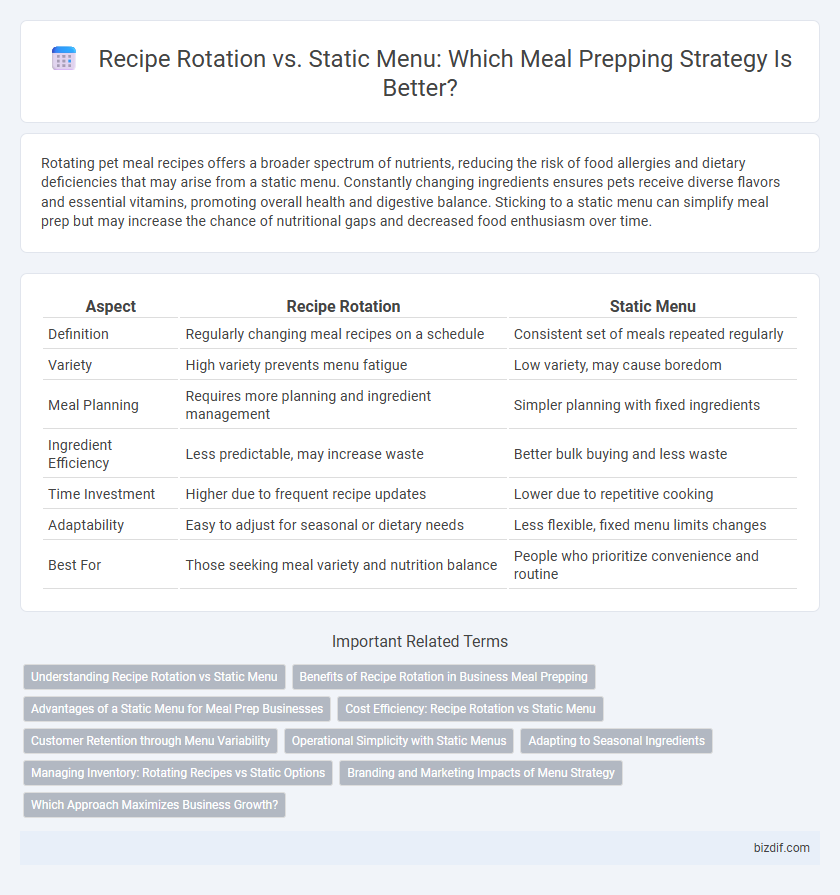Rotating pet meal recipes offers a broader spectrum of nutrients, reducing the risk of food allergies and dietary deficiencies that may arise from a static menu. Constantly changing ingredients ensures pets receive diverse flavors and essential vitamins, promoting overall health and digestive balance. Sticking to a static menu can simplify meal prep but may increase the chance of nutritional gaps and decreased food enthusiasm over time.
Table of Comparison
| Aspect | Recipe Rotation | Static Menu |
|---|---|---|
| Definition | Regularly changing meal recipes on a schedule | Consistent set of meals repeated regularly |
| Variety | High variety prevents menu fatigue | Low variety, may cause boredom |
| Meal Planning | Requires more planning and ingredient management | Simpler planning with fixed ingredients |
| Ingredient Efficiency | Less predictable, may increase waste | Better bulk buying and less waste |
| Time Investment | Higher due to frequent recipe updates | Lower due to repetitive cooking |
| Adaptability | Easy to adjust for seasonal or dietary needs | Less flexible, fixed menu limits changes |
| Best For | Those seeking meal variety and nutrition balance | People who prioritize convenience and routine |
Understanding Recipe Rotation vs Static Menu
Meal prepping benefits from understanding recipe rotation versus static menus, where recipe rotation involves regularly changing dishes to maintain variety and nutritional balance, preventing meal fatigue. Static menus offer consistency and ease by repeating the same meals, making planning and grocery shopping more straightforward but risking monotony. Evaluating personal preferences and lifestyle needs helps determine whether rotating recipes or sticking to a fixed menu enhances meal prep efficiency and enjoyment.
Benefits of Recipe Rotation in Business Meal Prepping
Recipe rotation in business meal prepping enhances customer satisfaction by offering variety and reducing meal fatigue. This strategy boosts nutritional balance by incorporating diverse ingredients and preparation methods, catering to dietary preferences and restrictions. Furthermore, rotating recipes can improve operational efficiency by optimizing inventory management and minimizing ingredient waste.
Advantages of a Static Menu for Meal Prep Businesses
A static menu in meal prep businesses streamlines inventory management and reduces food waste by allowing consistent ingredient ordering. It enhances operational efficiency through simplified staff training and predictable preparation routines. Consistency in meal quality and taste builds customer trust and encourages repeat orders, boosting overall business stability.
Cost Efficiency: Recipe Rotation vs Static Menu
Recipe rotation enhances cost efficiency by utilizing seasonal ingredients and reducing ingredient waste, leading to lower overall grocery expenses compared to a static menu. Static menus often require purchasing the same items repeatedly, increasing costs due to lack of flexibility and bulk buying opportunities. Implementing recipe rotation enables meal prepping to adapt to market price fluctuations, optimizing budget management.
Customer Retention through Menu Variability
Implementing recipe rotation instead of a static menu in meal prepping significantly enhances customer retention by offering diverse flavor profiles and nutritional options, reducing meal fatigue. Regularly updated menus cater to evolving customer preferences and dietary needs, fostering sustained engagement and satisfaction. Data shows that businesses incorporating menu variability experience up to a 25% increase in repeat orders compared to those with fixed meal plans.
Operational Simplicity with Static Menus
Static menus enhance operational simplicity by standardizing ingredient lists and preparation methods, reducing kitchen errors and streamlining inventory management. Consistent recipes enable staff to master cooking techniques, minimize training time, and optimize meal prepping efficiency. This approach supports cost control and predictable portioning, crucial for maintaining budget and quality in meal prepping operations.
Adapting to Seasonal Ingredients
Rotating recipes seasonally maximizes freshness and nutrition by utilizing ingredients at their peak availability, enhancing meal variety and flavor profiles. Static menus often rely on a fixed set of ingredients, which can lead to decreased variety and nutrient density as seasonal produce comes and goes. Adapting meal prep to incorporate seasonal ingredients supports sustainable eating habits and optimizes cost efficiency by leveraging local market availability.
Managing Inventory: Rotating Recipes vs Static Options
Rotating recipes in meal prepping enhances inventory management by utilizing a diverse range of ingredients, reducing waste and ensuring fresher produce consumption. Static menus simplify shopping lists and streamline ingredient purchases but can lead to overstocking specific items and increased spoilage. Balancing rotation with staple options optimizes kitchen efficiency and cost control while maintaining menu variety.
Branding and Marketing Impacts of Menu Strategy
Recipe rotation enhances brand perception by showcasing culinary variety, attracting a broader customer base and encouraging repeat purchases. Static menus reinforce brand identity through consistency, making marketing messages more memorable and building customer loyalty. Balancing recipe rotation with a signature static core can optimize brand differentiation and customer engagement.
Which Approach Maximizes Business Growth?
Recipe rotation introduces variety that attracts repeat customers by catering to diverse tastes and seasonal ingredients, driving higher sales and customer retention. Static menus offer operational efficiency through streamlined inventory and consistent quality, reducing costs and improving profit margins. Businesses balancing innovation from recipe rotation with the reliability of static menus often experience the most sustainable growth and competitive advantage.
Recipe rotation vs static menu Infographic

 bizdif.com
bizdif.com